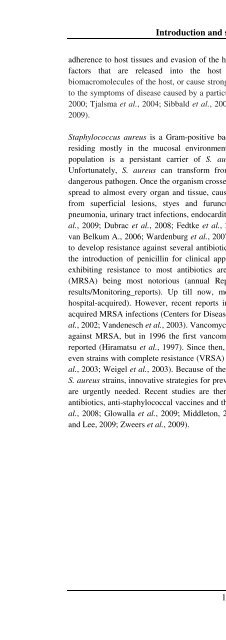The Staphylococcus aureus secretome - TI Pharma
The Staphylococcus aureus secretome - TI Pharma
The Staphylococcus aureus secretome - TI Pharma
You also want an ePaper? Increase the reach of your titles
YUMPU automatically turns print PDFs into web optimized ePapers that Google loves.
Introduction and scope of this thesis<br />
adherence to host tissues and evasion of the host defense systems. In addition, the virulence<br />
factors that are released into the host milieu may damage host cells, degrade<br />
biomacromolecules of the host, or cause strong inflammatory responses, thereby contributing<br />
to the symptoms of disease caused by a particular bacterium (For reviews see Tjalsma et al.,<br />
2000; Tjalsma et al., 2004; Sibbald et al., 2006; van Dijl et al., 2007; Sibbald and van Dijl,<br />
2009).<br />
<strong>Staphylococcus</strong> <strong>aureus</strong> is a Gram-positive bacterium that is part of the human microbiota,<br />
residing mostly in the mucosal environment in the nose. In fact, ~20% of the human<br />
population is a persistant carrier of S. <strong>aureus</strong>, while 60% is an intermittent carrier.<br />
Unfortunately, S. <strong>aureus</strong> can transform from an apparently harmles commensal into a<br />
dangerous pathogen. Once the organism crosses the defense systems of the human host, it can<br />
spread to almost every organ and tissue, causing a wide range of diseases. <strong>The</strong>se can vary<br />
from superficial lesions, styes and furunculosis, to more serious infections such as<br />
pneumonia, urinary tract infections, endocarditis, and in rare cases even meningitis (Cheng et<br />
al., 2009; Dubrac et al., 2008; Fedtke et al., 2004; García-Lara et al., 2005; Novick, 2003;<br />
van Belkum A., 2006; Wardenburg et al., 2007). Moreover, S. <strong>aureus</strong> has an amazing ability<br />
to develop resistance against several antibiotics, which became evident already shortly after<br />
the introduction of penicillin for clinical applications. In the mean time, S. <strong>aureus</strong> strains<br />
exhibiting resistance to most antibiotics are known, the methicillin resistant S. <strong>aureus</strong><br />
(MRSA) being most notorious (annual Report EARSS 2007; http://www.rivm.nl/earss/<br />
results/Monitoring_reports). Up till now, most MRSA infections were nosocomial (i.e.<br />
hospital-acquired). However, recent reports indicate an increase in dangerous communityacquired<br />
MRSA infections (Centers for Disease Control and Prevention, 2003; Grundmann et<br />
al., 2002; Vandenesch et al., 2003). Vancomycin has been for long time a last resort antibiotic<br />
against MRSA, but in 1996 the first vancomycin intermediate resistant strain (VISA) was<br />
reported (Hiramatsu et al., 1997). Since then, several other cases of other VISA strains and<br />
even strains with complete resistance (VRSA) against vancomycin have been isolated (Cui et<br />
al., 2003; Weigel et al., 2003). Because of the anticipated rise of multiple antibiotic resistant<br />
S. <strong>aureus</strong> strains, innovative strategies for prevention and intervention of S. <strong>aureus</strong> infections<br />
are urgently needed. Recent studies are therefore focusing on the development of novel<br />
antibiotics, anti-staphylococcal vaccines and therapeutic protective antibodies (Arrecubieta et<br />
al., 2008; Glowalla et al., 2009; Middleton, 2008; Nanra et al., 2009; Otto, 2008; Schaffer<br />
and Lee, 2009; Zweers et al., 2009).<br />
11













